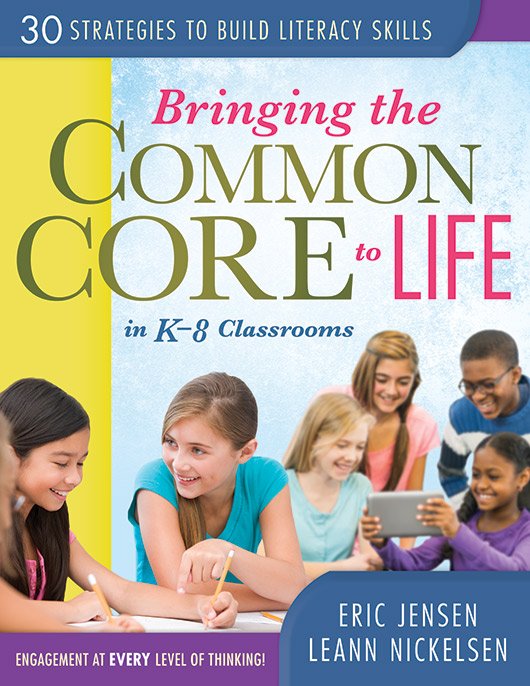Free Reproducibles
A book for Common Core Lesson Plans | Bringing the Common Core to Life in K–8 Classrooms
30 Strategies to Build Literacy Skills
Actively engage students in their own learning. Discover strategies to promote student mastery of the Common Core State Standards for English language arts across the curriculum. Explore techniques to lead students in close reading, activate their background knowledge to prepare them for learning, and gain insight into habit formation. You'll develop the know-how to effectively structure teaching to empower all students.
Benefits
- Understand the components of engaged classrooms, and create an environment where students are active participants in their learning.
- Structure learning that encourages students to work smarter, not harder.
- Teach students to engage emotionally with text and to retain and explain what they read.
- Distinguish between top-down, passive classrooms and two-way engaged-for-success classrooms that promote higher-level thinking and learning.
- Complement Common Core lesson plans with CCSS-based activities, lists, and other reproducibles.
TABLE OF CONTENTS
Chapter 1: Success Formula for Engagement
Chapter 2: The Common Core State Standards
Chapter 3: How to Turn Standards Into Targets
Chapter 4: Zone 1: Engage to Build Basics
Chapter 5: Strategies for Zone 1
Chapter 6: Zone 2: Engage to Explore
Chapter 7: Strategies for Zone 2
Chapter 8: Zone 3: Engage to Own
Chapter 9: Strategies for Zone 3
Chapter 10: The Big Picture
Appendix A: Incorporating Differentiation
Appendix B: Matching the Engagement Strategies With Anchor Standards
PRINTABLE REPRODUCIBLES
Chapter 1
- Criteria for Engagement: Primary (Grades K–3)
- Criteria for Engagement: Intermediate (Grades 4–8)
- Learning Preferences: Primary (Grades K–3)
- Learning Preferences: Intermediate (Grades 4–8)
- Subject Area Interests and Strengths: Primary (Grades K–3)
- Subject Area Interests and Strengths: Intermediate (Grades 4–8)
- “Who Are You?” Interest Inventory
Chapter 3
- Cruisin’ Clipboard Documentation
- Daily Stoplights Student Self-Assessment
- Daily Targets Student Self-Assessment
- My Progress Learning Graph
- Weekly Progress Monitoring
Chapter 5
- Historical Event Web: Primary (Grades K–3)
- Historical Event Web: Intermediate (Grades 4–8)
- IDEA Vocabulary Organizer
- The Important Book: Primary (Grades K–3)
- The Important Book: Intermediate (Grades 4–8)
- Reporter Goes Big Time
- Super Sleuth
- Skimming and Scanning: Primary (Grades K–2)
- Skimming and Scanning: Intermediate (Grades 3–5)
- Skimming and Scanning: Challenging (Grades 6–8)
Chapter 7
- Brainstorming Bonanza
- Brainstorming Bonanza Checklist
- Credible and Accurate Resource Tracker
- Different Perspectives
- Presentation Rubric: Primary (Grades K–3)
- Presentation Rubric: Intermediate (Grades 4–8)
- Reflective Conversations With Nonfiction Checklist
Chapter 9
- Additional Reciprocal Teaching Role Cards for Grades 4–8
- Close Reading Marks
- Daily Door Pass for Interactive Notebooks
- Interactive Notebook
- Interactive Notebook: End of Unit Reflection
- Reciprocal Teaching Cards: Primary (Grades K–3)
- Reciprocal Teaching Cards: Intermediate (Grades 4–8)
- Reciprocal Teaching Conversation Notes
- Reciprocal Teaching Self-Assessment Form
- Self-Assessment and Rubric for Interactive Notebook
- Socratic Seminar Evaluation
- Stop-n-Think for Primary Students
- Stop-n-Think With Checkpoints
- Student Steps for Reciprocal Teaching
- Walking in the Shoes of Another
Chapter 10
SUGGESTED RESOURCES
- Common Core State Standards
- CCSS Appendix A
- CCSS Appendix B
- CCSS Appendix C
- FutureMe
- Granite School District
- Greece Central School District
- The Lexile Framework for Reading
- Merriam-Webster
- Neag Center for Gifted Education and Talent Development
- Ninja Words
- NoodleTools
- PARCC
- The Reading & Writing Project
- The Reading & Writing Project: Reading Assignments
- Reciprocal Teaching for the Primary Grades: "We Can Do It, Too!"
- SBAC
- stickK
- Student Achievement Partners
- ThinkCERCA
- Thinking Maps
- WebQuest

